Preprint
Article
Re-Visiting Viking Vinland: II. 'Virtual Excavation' of 'Keelness', a Viking Shipwreck Site in North America
This is a preprint, it has not been peer-reviewed.
Submitted:
18 January 2023
Posted:
20 January 2023
You are already at the latest version
Abstract
The series of papers, 'Re-Visiting Viking Vinland', encompasses a re-evaluation of the Viking voyages from Greenland to North America, from about 985 to 1026 A.D. Searching for their American landfalls used multiple approaches: clues from Norse sagas, logic, creative imagination, and advanced imaging technology. Paper I described locating 'Keelness', a Viking shipwreck site in Newfoundland, Canada, but Covid-19 prevented professional, on-site follow-up. Paper II describes our alternative, a 'virtual excavation', using only remote imaging via drone, plus advanced data-processing of both visible and thermal (infrared) data. Starting with the 'stocks', a support structure for Viking ship repair, other features were accidentally found, identified, and interpreted. These included damaged hull planks ('strakes'), parts of the broken keel, a pit-house for shelter, and the hole where a keel-piece was erected as a navigational marker; with the site named (Norse, 'Kjalarnes') ('Keelness' or Keel Point). Results of this non-contact, non-destructive 'virtual excavation' supported our hypothesis that this site is the 'Keelness' mentioned in the Norse sagas. Fragments of Leif Eriksson's original ship may still be preserved in a sphagnum moss bog after 1000 years, accessible for further study, and perhaps providing valuable information on both provenience (origin) and provenance (history) of these iconic artifacts.
Keywords:
-
Introduction
1. 'Re-visiting Viking 'Vinland''- the Series
'Re-Visiting Viking Vinland' is a series of papers describing re-evaluation and re-interpretation of Viking voyages from Greenland to North America, dating from about 985 to 1026 A.D. Paper I described the voyage of Leif Eriksson's brother, Thorvald Eriksson, and locating his shipwreck site, 'Keelness', in Newfoundland, Canada (1). Covid-19 fallout restricted site access and affected the ability to enlist certified professional assistance for follow-up. As an alternative, a 'virtual excavation' of the entire ship repair site was carried out, using only imaging data from preliminary drone scans, as described here in Paper II. Later papers will address imaging evidence for the site of Thorvald's subsequent death, and a later voyage led by Thorfinn Karlsefni, who may also have occupied this same site.
2. Paper I Re-cap
Paper I described the circumstances of Thorvald's fateful voyage, and how we re-imagined his route from 'Leif's Booths' to 'Keelness'. Figure 1 shows the heart of 'Vinland', including specific landmarks and locations. It also summarizes the first two phases of this project; locating Leif's Booths, the voyage's starting point, and tracing Thorvald's trajectory to the shipwreck site.
The entire shipwreck episode was described in Greenlanders' Saga (GS) in only three cryptic sentences (with 'clues' to the discovery highlighted):
“Next summer Thorvald sailed east with his ship and then north along the coast. They ran into a fierce gale off a headland and were driven ashore; the keel was shattered and they had to stay there for a long time while they repaired the ship. Thorvald said to his companions, ‘I want to erect the old keel here on the headland, and call the place Kjalarnes (Keelness)” (Magnusson and Palsson, 1965) (2).
Using saga clues, logic, and creative imagination, we described the process by which we located his shipwreck site, on the north coast of the Great Northern Peninsula, in Newfoundland, Canada. A single satellite image suggested a support structure, characteristic of Viking ship construction. Drone imaging verified our sighting, while accidentally revealing other ground features, and reinforcing our initial suspicions. We ended Paper I with a topographic map of the entire ship repair site, showing the visually enhanced topography, locating the features, and alluding to our initial analysis of the finds.
The ship was rebuilt, perhaps over two calendar years (GS states merely a "long time"), and eventually carried the crew (minus Thorvald) safely back to Greenland. When confirmed, 'Keelness' (Keel Point) will be the first specifically named Viking site found in North America, located at 51O.36'.54.36" N, 55O.51'.21.02" W. Only 22 km (14 miles) from L'Anse aux Meadows (LAM), suggests a connection between the two sites, (Figure 11), and it is very plausible that both sites were established and occupied at the same time.
3. Difficulties in Viking Vinland Research
A very recent paper by Ulrich Johann, pursuing a similar investigation, has likewise addressed the inherent difficulties in pursuing this subject (3). The Vinland sagas are essential, because they are the only documentary source we have. But they are fraught with difficulty, because there is so little information; much of it surely fiction, the rest questionable, and no way to tell the difference. On the other hand, assuming that everything in the sagas is fiction, makes trying to locate Viking sites little better than throwing darts at a map. Except for Helge Ingstad (L'Anse aux Meadows), more than 200 years of intense scholarship has failed. Previous historians maybe succumbed to the illusion that saga 'facts' were somehow 'proof' of their hypotheses, rather than preliminary clues of where to look by other means. With many new technologies presently available, now was the time to try anew. We are in agreement that everything will remain hypothetical, until excavations take place, and artifacts are authenticated. Until then, the search is equally as engaging as any discovery, and perfect for retired scientists, with time on their hands.
4. Presentation of the Narrative
Our results may be presented as, 'this is the way it might have happened', in the interests of brevity and continuity, but in reality, we don't know and will probably never know the 'truth'. These hypotheses are just that, working hypotheses; the best we can do, with the limited information available, and that is how they should be interpreted. We are not naive enough or egotistical enough to think that what we present is the 'truth'. It is just a starting point, for professional archaeologists to eventually extend our knowledge and understanding of this pivotal era of human civilization.
Materials and Methods
1. The 'Vinland' Sagas
As previously described, the foundational materials for this study were the Norse 'Vinland' sagas, Greenlanders' Saga (GS), and Erik the Red's Saga (ERS). Some Vinland scholars still insist that these sagas are merely fictional, but we found them essential for imagining locations and events so vividly described. Despite indisputable flaws, they are still the only documentary, eyewitness reports available, and our study shows that some degree of confidence in the sagas was justified. Creative imagination fills in the gaps, resulting in a comprehensive narrative which can perhaps serve as a guide for further archaeological investigation.
2. Maps and Geography
Progress in Vinland Viking history was hampered for close to two centuries by the inadequacy of available maps. The futile, non-productive search for 'Vinland' on the northeast coast of the United States may have been due as much to poor maps, as it was to misplaced patriotism. Only recently, with satellite imaging, have highly detailed maps become widely and publicly available, (Google Earth, Apple Maps, ESRI, Maxar Technologies, satellites.pro, etc.), revolutionizing both, geography and subsequently archaeology. Satellite imagery allowed us to imagine the trajectory of the ship (map, Figure 1). Since a shipwreck was involved, we integrated nautical maps and underwater topography to identify structures which could have contributed to a shipwreck. Modern nautical charts, were used to create an imaginary scenario, consistent with both topography and climatology, as described in Paper I.
3. Remote Sensing - Drone Imaging
Technical details of the equipment, techniques and methods used for data acquisition and analysis will be covered in a separate paper (Franklin et.al., in preparation). Here we concentrate primarily on the interpretation of the imaging, and how that was used to construct a plausible narrative for the activities which may have occurred on this site.
A suspicious satellite image of unnatural parallel lines might previously have triggered a physical site excavation; but another recent attempt at locating a Viking site in Newfoundland had failed at exactly this point. For us the temptation was moot because, as non-professionals without a permit, we could not pursue an excavation anyway; and enlisting professional help based on a single satellite image was impossible. Changing direction, and primarily just to confirm the authenticity of a satellite image, we turned to non-contact, non-invasive, non-destructive drone imagery. In our judgement, remote imaging was benign, posing no more danger to the site (perhaps even less) than tourists taking photographs; scanning only public property, and controlled from a public right-of-way (ROW) to protect the physical integrity of the site. Because this site was rather remote, there was considerable cost for the drone deployment alone. But since the basic cost was already committed, we made the strategic decision to scan as much area as geographically and economically feasible, while adding thermal (infrared) imaging to the sensing suite. In retrospect, this turned out to be a wise decision.
If the satellite image were to be confirmed, and with thermal imaging as an extra dimension, there could be other features, undetectable by satellite imaging alone. It was a calculated gamble, but ultimately successful. The drone imaging accidentally revealed not only numerous additional surface features, but also sub-surface features (via thermal/infrared). With in-person investigation restricted by Covid-19, advanced, digital data-processing was applied to the preliminary drone data, creating detailed 'virtual' images, as described in Results and Discussion.
4. Data-processing - visible
The raw drone data, taken from an elevation of about 130 ft (40 m), in the visible spectrum, was processed using ArcGIS software developed by Environmental Systems Research Institute (Esri, formerly ESRI). This methodology was previously used by co-author M.S.F., in researching neglected Black cemeteries in Richmond, VA., by creating various 'synthetic images' (especially hillshade) for 'enhanced visualization' and analysis (4). Examples of the results in this application are presented in Results and Discussion, amply demonstrating the value of this technology.
5. Data-processing - thermal/infrared
An excellent overview, regarding use of aerial thermography on archaeological sites is given in a paper by Casana et. al (2017) (5). Thermal/infrared scans were processed using FLIR (Forward Looking InfraRed) software, accentuating the varied thermal signatures of both surface and sub-surface objects and features. FLIR advanced thermography is a technology originally developed for the US military, but now with many civilian applications. The website of the manufacturer, Teledyne, is most informative on the specifics of FLIR (6). Most readers will be unfamiliar with thermography, and especially its use in archaeology, so a brief tutorial may be helpful.
Thermographic sensors and instruments do not measure temperature directly, as by contact, and do not create 'real' images, as with a photograph. Instead, they remotely detect and measure infrared (thermal) radiation being emitted by objects in their view. All material objects absorb energy from their environment, but they re-emit that energy with varying degrees of efficiency, on a scale of 0 to 1.0. This efficiency is called emissivity. Zero (only theoretical) is like a perfect mirror, which reflects all light, without absorbing any of its energy. At the other end of the scale, 1.0 is a 'perfect black body', which absorbs 100% of the energy impinging on it, and then re-emits 100% of that energy, at a wavelength NOT related to its composition, but directly related to its temperature. This is detected by the FLIR system as 0 being 'colder' than 1 being 'hot'. Advanced cryogenically cooled sensors are now capable of measuring 0.025o C differences! Our results were not as discriminatory, but impressive nonetheless, and more than adequate for locating, identifying, and analyzing sub-surface archaeological features.
Emissivity is not only affected by the identity of the material itself, but by its surface characteristics: texture (roughness), density, chemical effects (e.g. oxidation/corrosion), hydration, geometry, view angle orientation, etc.). All of these surface effects on the emissivity allow incredible discrimination between objects in the image, which can be enhanced by 'tuning' the data-processing phase of the analysis. The detection system measures the intensity of the radiation in every pixel of the sensor, at rapid intervals, and stores that information in a digital format. As one can imagine this results in an incredible amount of stored data; taking hours or days to download, days or weeks to process, and weeks or months to analyze. Computer processing of all the data, produces useable images, with incredible discrimination, fidelity, and malleability. As stated, the output does not produce a true image, like a photograph, but a 'synthetic image' which can be digitally manipulated and enhanced at will, enhancing different information about the objects in view.
6. Logic and Imagination
The combination of logic and creative imagination had paid off in locating the shipwreck site (1). Now the time had come, to not only pinpoint locations of specific features, but to see if this same strategy could be applied to interpret the roles which these features may have played in the overall ship repair narrative.
7. 'Virtual Excavation'
Unable to enlist and/or retain a qualified archaeologist for on-site investigation/excavation, we turned to a 'virtual excavation'. Here, remote, non-invasive, non-contact digital imaging, advanced data-processing, and human imagination, substitute for trowels, buckets, brushes, and screens. Physical excavation will still ultimately be required to tell the complete story, filling in details which only 'hands-on' activity can provide. But until that becomes possible, a detailed overall view of the entire ship repair site, and a basic outline of the ship repair narrative will be waiting, for others to confirm, refute, expand, modify, or ignore as they deem appropriate.
Results and Discussion
1. Confusion - 'Stocks' and 'Strakes'
With a high degree of confidence in locating the 'Keelness' site, this is where we transitioned from merely confirming a satellite image, into a full-fledged 'virtual excavation'. Without site access, we needed creative imagination to analyze the preliminary drone data, and then advanced data-processing to interpret what we were seeing. We were initially stunned, and puzzled, when we saw the first visible image of the feature tagged by GPS on the satellite image. This first image was a series of parallel lines, but a completely different pattern than the one we expected. After much concern and confusion, we realized that this was not the one we were looking for. Fortunately, serendipity had smiled upon us, and looking around on the wider image, we eventually found our original target.
It turned out that there were actually two different sets of parallel lines, within about 150 ft of each other. By truncating the GPS decimal points, they had showed up at exactly the same GPS location on the scans. After weeks of analysis and interpretation, we concluded that the first drone image suggested an array of damaged hull planks (called 'strakes'), removed from the hull, and perhaps used as patterns or templates for replacements. We return to this feature later, but for now we follow up on the original satellite image; interpreted as the 'stocks'. We tried to get input from experts in Viking ship construction and repair, without success. The descriptions which follow are our amateur attempts to visualize the challenges the crew faced, and what the images tell us about how they might have dealt with them; hypothetical, but at least plausible.
Figure 2.
ArcGIS hillshade image of entire ship repair area, with primary features indicated.
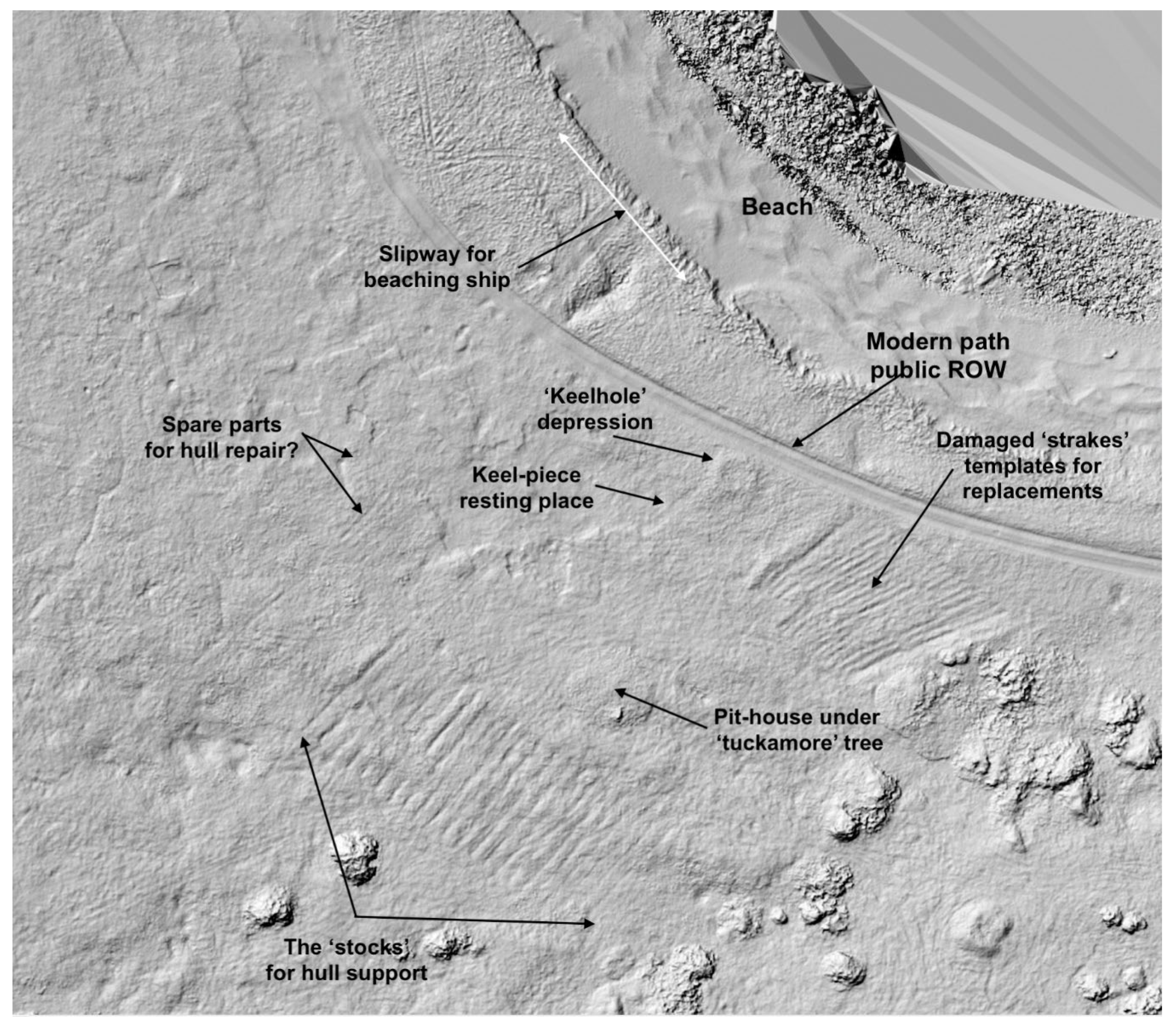
2. Stocks
Preparing for repair, they had to construct the 'stocks', a stable base on which to elevate and stabilize the hull. See Paper I, Figure 8A,B, and associated Smithsonian Institution YouTube video (7) for how this structure was used. This job called for ingenuity. Normally, a Viking ship was constructed on the stocks, from the keel up, adding one strake at a time, and as it grew, adding additional 'props' along the outside of the hull for support. But here, the keel and the entire underside of the ship had to be replaced: the keel and 18 strakes, 9 strakes on either side of the keel. Figure 3, the Myklebust Viking ship reproduction, illustrates the extent of the repair. During disassembly, it would have to be supported almost entirely by the inner framework (possibly from above), and outside props angled only to the upper part of the hull. This is where professional input would have been invaluable, but unfortunately not available.
The drone hillshade image, (paper I, Figure 7B), showed that 22 logs, each about 52 ft (16m) long, had been laid down on 6.6 ft (2 m) spacing, probably connected by perpendicular 'stringers' underneath (no longer detectable). There was surely plenty of driftwood of all sizes available on-site: perhaps damaged by Teredo shipworm, but adequate for this temporary application. The entire stocks array had a length of about 135 ft (42 m), indicating that this structure was intended for a huge ship, probably at least 85 ft (26 m) long. With the stocks completed and ready to receive the hull, now they had to get the hull from the cove where it was resting, to the stocks (see paper I, Figure 4).
3. Slipway
First, they had to get the ship out of the water; how did they do that? This was a huge ship for its time, probably around 85 +/- ft long (26 m), 22 +/- ft (7 m) wide, weighing 20 to 30 tons (18,000 - 27,000kg), cargo capacity of >80 tons (73,000 kg). This is much larger than most other, previously known, ocean-going, Viking 'knerrir' (plural of 'knarr'). With only perhaps 25 crew available, everything about handling this ship would be a challenge. With input from someone familiar with sailing and servicing a lapstrake ship, we constructed the following narrative, but still hypothetical and subject to change at any time.
Their first task was probably to assess the extent of the damage, before Thorvald could formulate a plan of how to proceed. With significant holes in the hull, and tons(?) of ballast rocks still inside, the ship was probably gently resting on the bottom of the cove, with the underside of the ship under several feet of water. They needed to beach it, so they could assess the condition of the bottom strakes, from both inside and out. We think they may have maneuvered the ship parallel to the shoreline, and as close as possible. To lighten the hull, they likely removed the ballast stones and stockpiled them on the beach, for later reuse. On the next set of really high tides, they would have careened the ship on the beach, perhaps using the mast as a lever, tipping the ship over to one side, and then on the next tide, over to the other side. This would allow inspection both inside and out, while mentally putting together a materials list, and formulating a plan for reconstruction. They must have immediately realized that this would not be easy, much more than a simple repair, and more like a reconstruction, replacing the entire keel, and all 18 bottom strakes.
We think that they may have constructed a set of 'cradles', and attached them at intervals along the hull, preserving and stabilizing the shape and structure as much as possible. Connecting the cradles laterally to each other, and with a multitude of props up to the upper strakes, they could now handle the entire ship as a relatively stable and cohesive whole, and be able to maneuver it in all directions by means of levers and rollers. The extent of the damage probably dictated construction of a sturdy set of stocks as described earlier.
Scanning the nearest shoreline, there is one straight stretch of shore, which appeared to have short 'stubs' jutting out at repetitive intervals (Figure 2). This suggested that, with the ship already on the beach, they might have constructed a 'slipway', for pulling it up sideways, to get it well clear of the water. We imagined them using long, uniformly sized driftwood logs (maybe 50 +/- ft (16 m long), similar to the construction of the stocks. If true, they may have placed logs about 2 ft apart, perpendicular to the waterline, with the total array about 85 ft wide. Attaching the cradles would have been a challenge; perhaps assembled while the hull was still careened on the beach between tides. With the cradle assembly securely in place, they may have attached extremely strong walrus-hide ropes to both bow or stern. Perhaps with an A-frame lever device for force-multiplication, they could then 'walk' the ship up the incline, very slowly, one end at a time. With the hull at the top of the slipway on more level ground, they could then proceed to slide the ship about 130 ft (40 m), over to the waiting stocks: likely using a combination of log rollers over trackways for support, and levers for both pushing and pulling.
4. Imagining the Ship
Even scholarly publications portray Leif Eriksson's ship as a high-status 'longship' (Norse: 'langskip'), with dragon head prow, and row of shields along the gunwale; romantic, visually appealing, but surely false. Leif's ship would have been a 'knarr', a merchant ship, a freighter designed to carry as much valuable cargo as possible. Evidence for two separate pieces of the broken keel at Keelness (described later), suggest a total keel length of about 65+ ft (20 m); consistent with a ship close to 85 ft (28 m) long overall. By comparison, combined length of excavated keel pieces of the Bryggen 'Big Ship', excavated in Bergen, Norway, is 74 ft (23 m). Experts estimated the length of that ship at about 27 - 30 m (89 - 99 ft); so certainly, in the same size range (8). The relatively straight, ~72-foot central sections of the 'strakes', described below, are again consistent with an 85 +/- ft long ship.
Because of its size, experts speculated that the Bryggen "Big Ship" may have been a king's ship, or perhaps owned and operated by a wealthy merchant cooperative, rather than a single individual. With the 'Keelness' ship we speculate, that as presumptive paramount chief of Greenland after Erik the Red's death, Leif may have felt entitled to such extravagance; and with the rewards from his Vinland trip, the gamble seemed to have paid off. If even close to correct, this was a substantial ocean-going ship, bigger than most known 'knerrir' (pl.) of that time, and about 200 years before the Bryggen ship. The goal was cargo volume, and the more, the better. Cargo was money, and these were hunter-gatherers and merchants first, explorers a distant second.
5. 'Strakes'
We now return to the 'strakes'. The other set of parallel lines was initially a confusing puzzle: 18 of them, very long, about 72 ft (22m), and narrow, about 16 in wide (38 cm). Entertaining various ideas: a wood lot, glacial striations on rock, and even the rows of an abandoned potato patch (!), we eventually imagined them as an array of damaged hull planks (‘strakes’), removed from the bottom of a damaged Viking ship. Figure 4A,B shows the drone imaging in both visible spectrum (4A), and the ArcGIS hillshade derivative image (4B), showing the value of this transformation. But why were they laid out so neatly, and left there? In our hypothesis, they may have been laid out in the order of their positions in the hull and used as patterns or templates for fabricating exact replicas, using local 'green' wood. Nearby LAM had previously been suggested as the site of a boat repair, because of the concentration of cleaved boat rivets found during excavations (99 total). Wooden artifacts were also found, suggesting templates for reproduction of damaged parts, so our idea was neither unusual nor unique (9). Viking ship experts questioned this interpretation, but declined to suggest an alternative, so at this time we see no better or reasonable alternative. Eventual excavations may reveal the answer, but ultimately, we may never know for sure.
6. Thermal Images
Now we turn to more 'synthetic images', combining both ArcGIS and FLIR; revealing details not normally visible. These allowed us to 'zoom' down, seeing smaller and smaller details, down to the centimeter level, a true 'virtual excavation'. Initially, advanced data-processing had produced a topographic image (ArcGIS hillshade) of the area, showing the present surface contours, relative to the visible view Figure 4A,B), interpreting Figure 4B as the array of damaged strakes. Thermal imaging of this same feature now allowed us to 'see' beneath the surface, showing details not evident in the visible spectrum. Despite an intervening millennium, thermal imaging indicated that there might still be intact material beneath the surface.
Using Adobe Photoshop©, the thermal image was superimposed over the hillshade image, producing the striking result shown in Figure 5. The grey background is the hillshade surface image, showing the positions of the original objects; but by now expanded by sphagnum moss growth, and slowly accumulating environmental debris. The thermal image shows differential thermal radiation, relative to the surrounding matrix, emitted by objects below the surface. While much of the strake wood appears to have rotted away, this image suggests that a reasonable amount of wood may still be present and relatively intact, even after 1000+ years.
A consulting archaeologist stated that wood surviving for 1000 years would be "impossible", while a medieval historian declared it "inconceivable". However, wood artifacts were excavated at LAM (only 14 miles away) in almost perfect condition, and yet precisely dated to exactly 1021 A.D. (10). Wood preservation at LAM was due to 'unusual conditions': a continually wet, anaerobic, cold, peat bog. Could not conditions at this nearby shipwreck site be equally unusual, unexpected, and successful? Supporting evidence is the largely intact, 2000-year-old human remains ('bog bodies') and organic artifacts, recovered from sphagnum peat bogs in Europe (11). Sphagnum moss creates its own unique environment as it grows: constantly wet, acidic, and anaerobic, while secreting sphagnan, an antimicrobial polysaccharide which inhibits biodegradation. Sphagnum moss was documented on Burnt Cape, the next peninsula east of 'Keelness', and was tentatively identified at Keelness under almost identical environmental conditions. In this sub-arctic climate, a sphagnum bog expands by only about 0.5 to 1 mm per year (12). So, after 1000 years, we imagine the strakes 'cocooned' under about 18 inches (0.5 m) of sphagnum moss in a 'raised bog'. Strake wood from Leif Eriksson's original ship, exposed to conditions like the bog bodies, could well be 1000 years old!
We hypothesized 18 damaged strakes, from keel to waterline (see Figure 3), carefully removed, and kept as intact as possible. Packing them in local sphagnum moss, and keeping them continuously wet, would prevent drying, warping, and shrinkage, so they could be used as templates. This may be analogous to modern conservation procedures, where synthetic chemicals are used to infiltrate, and preserve both the shape and size of waterlogged wooden ship artifacts. Even though superb woodworkers, these Vikings were not ship-builders. But reproducing exact replicas of damaged strakes could mean the difference between life and death, when later sailing the rebuilt ship across the North Atlantic. This was important! The severity, scope, and location of this shipwreck now hinted at why the L'Anse aux Meadows site may have existed in the first place. With imagination, pieces of the puzzle appeared to be coming together.
Zooming in even further, another provocative find in our 'virtual excavation' were the white spots on the infrared images. Our drone expert (J.G.) identified them as 'thermal hot-spots' (Figure 6), suggesting metallic artifacts based on their enhanced differential thermal radiation (emissivity). 'Metal', juxtaposed with 'strakes' immediately suggested that remnants of individual rivets might still be present in-situ, which future physical excavation may confirm. 99 rivet remains (mostly rust) were excavated at LAM (13), leading to the conclusion that LAM was a shipbuilding / ship-repair site, and the same logic may also apply here.
7. Interpreting the Strakes
There were other interesting features of the strakes. There appears to be about 14 feet missing from the ends of 3 adjacent strakes, strakes 7, 8, and 9, numbered out from the keel, on the front starboard side (Figure 4B). We assume that after the initial, keel-shattering collision, the crew immediately headed straight for land, with the NE wind on the port beam, (Paper I, Figure 2 and Figure 3). Unfortunately, there was another, smaller rocky outcrop directly in their path, and with the ship sinking, we imagine them hitting this rock, with a glancing blow to the front starboard underside, fragmenting about 14 feet of wood off these three strakes.
Most of the other strakes appear fragmentary in the thermal image, evidenced by the 'tattered' appearance of the edges (see Figure 6), suggesting that much of the original wood has rotted away. In contrast, the sharpness and continuity of the outer edge of one strake (highlighted), suggests substantial, relatively intact wood. This may be the best sampling target when the time is right for radiocarbon dating, and possibly even dendrochronology; even perhaps enough to confirm age and provenance. Based on our hypothetical chronological narrative for the entire Vinland period, (to be described in a future paper) our guess is pine from the Trondheim area of northern Norway, cut down around 998 A.D.
Non-invasive thermal imaging evidence for objects 16 +/- inches (0.4 m) below the present surface was remarkable. Contrast this with total excavation of an extensive feature like this strake array, using standard excavation techniques. It would be costly in both time and money and could unintentionally impact diagnostic evidence of Viking shipbuilding materials and techniques. Pre-excavation image analysis of such iconic artifacts may enable 'precision excavation'. Only small segments of the most consequential parts of a feature may need to be exposed and analyzed, in order to develop the full historical narrative. Remaining material could then be conserved and secured in-situ; providing future generations of archaeologists the opportunity to apply new methods to relatively pristine archaeological material, using perhaps still unimagined future technology.
8. Additional Features
After the surprise of unexpectedly finding the strakes, the extended area revealed many other suggestions of human disturbance; too many to evaluate in detail. However, some features were easier to interpret, and are described below.
Keel Hole
Perhaps counter-intuitively, certain features are easier to identify at a lower magnification, with overall patterns more revealing than close-up details. This was most notable with the 'keel-piece' and the 'keel-hole': the hole where a segment of the broken keel was erected on Thorvald's orders. Magnified views (Figure 7) are still helpful however for size and shape determinations.
The 'synthetic image' of the 30 degrees from horizontal perspective (Figure 8) leaves little doubt about the identity of these features. It was in recognizing the keel-hole feature which cemented in our minds that we had in fact found 'Keelness'. Innovative excavation techniques may be essential with such unique and iconic artifacts. In fact, there may be no remaining physical material left at all to recover and study; perhaps just 'reverse images', or cavities of what used to be there!
Keel Piece
Southwest of the keel-hole, an outline resembled a keel-piece, about 30 ft long and 36 inches wide, perhaps violently torn from the keel-hole during another Nor'easter and hurled several feet from its base. One interpretation is that this may be just a 'compression image', initially made by the weight of the keel-piece impacting the surface, as it came down hard. Laying there for hundreds of years, with repetitive freezing and thawing, it's weight would further consolidate the ground underneath. But unprotected by sphagnum moss as with the strakes, the wood may have succumbed to weather and decay over the course of a thousand years; or perhaps more recently removed by scavengers or vandals. Ironically, this feature may have already been compromised when a series of unanticipated 'test-trenches' appeared, close to the exact location of this 'artifact' in 2021. One can only hope for the best, but it is possible that the drone image may be the only remaining evidence of the keel-piece.
One unexpected 'coincidence' was seeing almost identical keel-piece profiles, when parts of the Bryggen 'Big Ship', were excavated in Bergen, Norway in the 1950s and 1960s, as shown in Figure 9. (14). With this supporting image, and even without on-site confirmation, the image of keel-hole and adjacent corresponding keel-piece, are convincing evidence that this site is indeed 'Keelness'!
Our original hypothetical shipwreck narrative had the keel being "shattered" close to amidships when it impacted Priest Rock (see paper I) (1). With this one 30 +/- ft piece of the keel presumably accounted for, where was the other half? Scanning our imaging, a candidate emerged as indicated on Figure 4B, and labelled as '2nd piece of keel ~37 ft', and Figure 5, 'Remnant of keel-piece?'. The 18 strakes were laid out with such care, that the presumed keel-piece stands out quite clearly as being inconsistent with the overall layout of the strakes. With this piece approximately 37 +/- ft long, the combined keel length would be about 67 +/- ft, consistent with our estimate of an 85 +/- ft ship.
The thermal image of this 'keel' feature suggests that there may be remnants of several iron rivets, still embedded in the remaining wood (white 'hot-spots', Figure 6). This combination of possible keel and rivet remnants in close proximity, and accurately located, may make this a prime target for 'precision excavation' when the time comes. Confirming either one would be excellent, but confirming both together would almost guarantee that this was in fact Leif's ship.
Pit House
Another question; where did they live during this "long time"? An unanticipated find was more speculative, but equally interesting. After sheltering in temporary 'booths' (Norse: budir) right after the shipwreck, the crew would need a substantial on-site living structure while the repair was underway: protection from the unpredictable sub-arctic weather at the site. A wide, low, flat tree (~ 30 ft (9 m) wide) adjacent to the stocks, identified by a tree expert as black spruce, had the top of its canopy just above ground level, suggesting that it was growing in a depression. This immediately suggested a Viking 'pit-house', a structure usually used for temporary or low-status housing, or as an outbuilding or craft workshop. Thermal imaging of this low, stunted, prostrate tree, (referred to as 'tuckamore' in Canada, and 'krummholz' in Europe), suggestively revealed perhaps another set of indistinct, but roughly parallel lines in thermal imaging (Figure 9). These suggest remnants of roof beams of a square 'pit-house', erected right next to, and between, the stocks and the strake array: convenient for shelter in a sudden downpour, other inclement weather, and routine everyday accommodations.
Figure 10.
Thermal image of presumed pit-house remains, underneath a stunted ('tuckamore') black spruce tree.
Figure 10.
Thermal image of presumed pit-house remains, underneath a stunted ('tuckamore') black spruce tree.
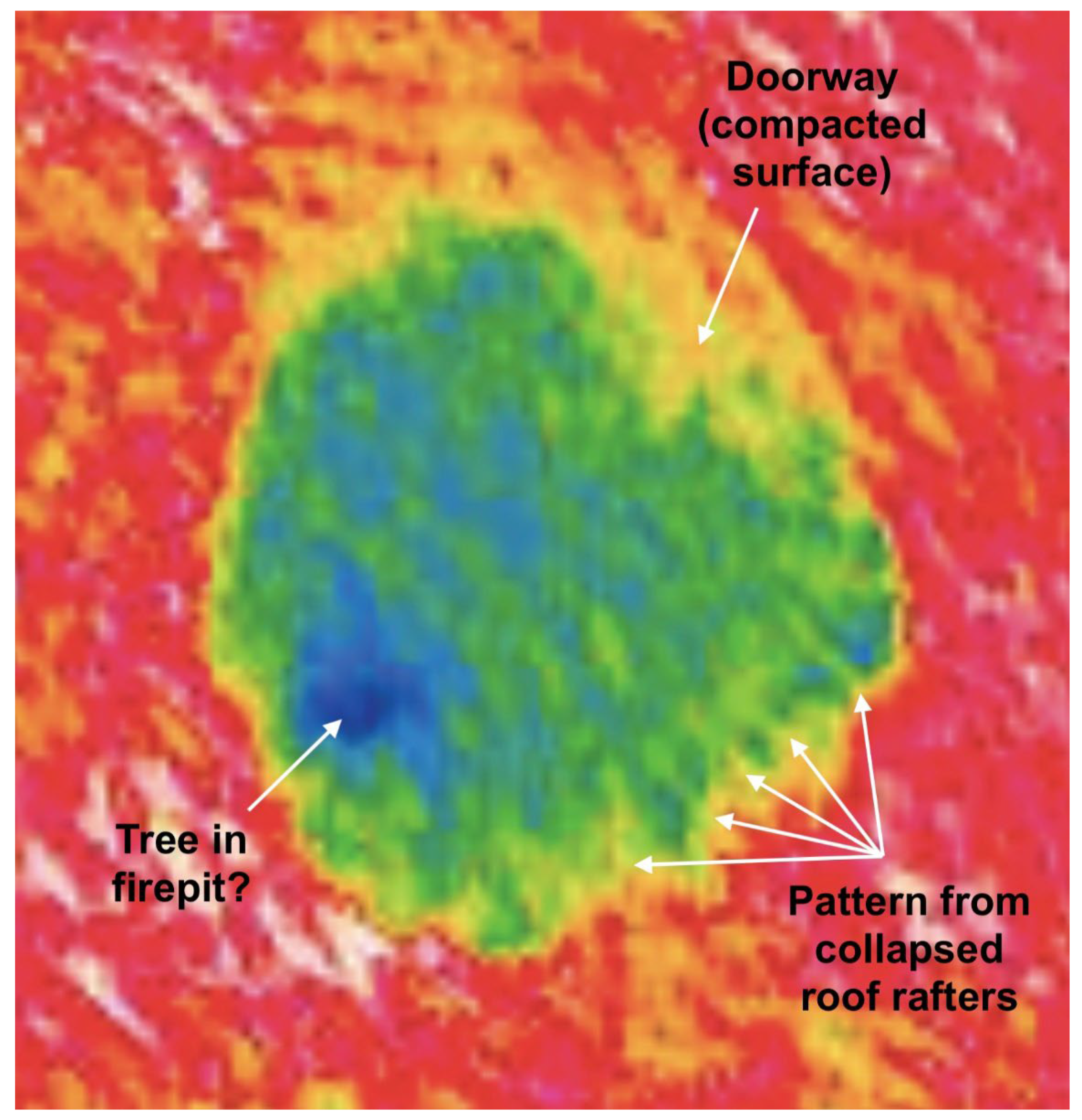
This extensive ship-repair must have taken a "long time", just as the saga states (GS). But even a pit-house would not offer sufficient room or protection for an upcoming winter, at such a hostile, exposed, sub-arctic location. Unable to consistently work outdoors, as autumn turned to winter, we believe that they retreated to the relative comfort of Hall A, the large sod house at LAM. We speculate that a work-party had already built the structure (or at least the southern half of it), for living space while smelting a single 'bloom' of iron for the ship repair, evidenced by the LAM excavations. Perhaps the north end of Hall A was added in the fall, to accommodate the entire ship's crew for the upcoming winter. This narrative suggests a compelling rationale for the unusual layout of Hall A, and the Hall A group of structures, being built at that place and at that time. This is where the Keelness - LAM connection may be more revealing.
The Archaeological Context
1. Aftermath
Remarkably successful, the repaired ship eventually completed this voyage, and made additional North Atlantic voyages before disappearing from history. With repairs finished, Thorvald ordered part of the broken keel erected on the 'nes' (Norse: point or promontory) as a nautical landmark; naming it 'Kjalarnes' (Keelness or Keel Point), before resuming their interrupted voyage (GS). A later expedition by Thorfinn Karlsefni also landed at 'Kjalarnes' (ERS), but rather than a brief stay implied in ERS saga, our analysis of the extended site suggests that they may have spent quite some time there, tending livestock, building houses at both Keelness and LAM, before moving on to 'Straumsfjord' the following year. This hypothesis will be discussed in a later paper.
Over the centuries, keel and pit-house shelter are blown down, perhaps in a nor'easter or hurricane. Sphagnum moss covers parts of the site, and Keelness disappears from memory, except for the sagas. However, 20+ men occupying the same site for "a long time", and undertaking a substantial construction effort, would be expected to leave ground disturbance patterns, still present and distinguishable even after 1000 years. That is what we imagined, and that is what we believed we had accidentally found.
Thorvald did not live long enough to bask in the glory of his remarkable achievement. Continuing their journey, Thorvald and crew foolishly killed eight of the local 'Skraelings'; perhaps ancestors of the now-extinct Beothuk First Nations culture. The Skraelings retaliated, and Thorvald was killed by an arrow, ricocheting up off the gunwale and into his chest. Mortally wounded, he ordered his burial at a beautiful site on a headland, with Christian crosses at his head and feet, reflecting his recent conversion. He ordered that the site be called 'Krossanes' (Cross Point) forever. 'Krossanes' has not been definitively located but will be in due time. To repatriate Thorvald's body a few years later, Karlsefni's group may have exhumed his remains, and taken them back to Greenland for a belated Christian burial in consecrated ground. A distinctive North American arrowhead, made of Ramah chert from Labrador, was excavated in a graveyard at Sandnes in Greenland's Western Settlement, in the 1940's (15). It is intriguing to think that it may have been the one which killed Thorvald, and eventually traveled all the way to Greenland in his remains; rather than just a travel souvenir from an anonymous Viking sailor.
Some historians seemed to consider the saga voyages as isolated events, with little connecting them into a cohesive whole: we chose otherwise. LAM has sometimes been portrayed as Leif Eriksson's 'home in Vinland' (Leif's Booths/Leif's House[s]), but it was never going to be Leif's original 'Vinland' landfall, as Helge and Anne Stine Ingstad had supposed; Newfoundland never had grapes. If our hypothesis is correct, the first LAM structures were erected by Thorvald Eriksson and his crew, to support their ship repair effort, several years after Leif's voyage. With Thorvald coming after Leif, it would be almost certain that LAM had no physical connection to Leif Eriksson at all. Leif's voyage would have been a few years earlier; lasting from summer of one year to spring of the next. It would have been just a quick 'in-and-out' trip, to the southern shore of the Gulf of St. Lawrence, to obtain valuable resources (hardwood lumber, grape wood, and raisins), and back to Greenland for some windfall profits; a true Viking entrepreneur.
Based on excavations, Ms. Birgitta Wallace concluded that LAM was not a 'Viking settlement'; due to short-duration occupancy, no animal enclosures, no domestic animal remains, no evidence of animal browsing, and no graves (16). From the numerous (99) fragments of iron rivets, she concluded that it was probably a ship repair location, as well as a 'gateway' to the larger 'Vinland' region further south; and perhaps a temporary 'stop-over' on voyages back and forth to Greenland. It may have been all of these things, but using only imaging evidence, we may be able to place LAM into a more realistic relationship with the rest of the 'Vinland' events.
On the annotated map of Thorvald's shipwreck location (Figure 11), we show the close proximity of Keelness to L'Anse aux Meadows. Also shown is the likely location for the 'green' wood needed for the ship repair. We speculate large white spruce trees about 10 miles away on the south shore of Pistolet Bay; with species verification still needed. Locating 'Keelness' so near to LAM, only about 14 sea miles (22 km), has certainly made a relationship between the two sites more plausible.
Our narrative suggests that Thorvald Eriksson and crew were the first inhabitants of the LAM site. To convert the bog-iron nodules found there, they built a furnace and smelted only one 'bloom' of iron; perhaps for a few special, large rivets to connect the new keel pieces. They may have built Hall A, house B and hut C for housing and workspace during summer/fall, and later protecting them from the upcoming harsh sub-arctic winter. It would be a more comfortable alternative to a pit house on the bleak, desolate, windswept expanse of 'Keelness'. Ms. Wallace estimated the range of living capacity for the LAM A-B-C building complex as from 21 to 30 people (minimum to maximum) (17). Our hypothesis of Thorvald taking 24 or 25 men with him on this voyage (out of his 30-man crew), would be entirely consistent with that estimate.
Having left the ship repair site secured and protected for winter, they would have returned to Keelness as early as possible the next spring (April/May?), completed the repair, and continued on their interrupted voyage of exploration, heading east as stated in GS. At a subsequent stop, the elation with their successful ship repair was dashed, when they encountered the native 'Skraelings'. Unprovoked, they killed eight 'Skraeling' fishermen, but in a revenge attack on their ship, Thorvald was killed, and their mission aborted. A later paper will further explore this episode.
2. Value of Virtual
Until now, remote imaging in archaeology has primarily been used to answer the 'where'; where were there ground patterns, indicating human presence and/or activity. In some cases, and with sufficient discrimination, imaging could sometimes point to the 'what'; large objects based on size and shape. But now, with increasingly detailed imaging and advanced data-processing, it may be possible to fill in the details, and outline a comprehensive site narrative. Addressing the 'who', 'how', 'when', and 'why', may facilitate a more effective excavation strategy, by already anticipating what the answers might be. One advantage of initial non-contact, non-destructive imaging is in leaving the original site undamaged and untouched. Detailed excavations can then start with a physically pristine site (except for ATV tracks, and other modern degradation), rather than one scarred with sometimes inconclusive test-trenches.
Despite the obvious advantages of 'big data', as presented in this work, there are a complex set of factors which need to be considered in its application to archaeology (18). Imaging especially is relatively expensive, as we found out, but technological improvements will continue to make it more accessible, easier to apply, and less expensive. In industrial/commercial archaeology, even with the costs of imaging and data-processing, savings made possible by better pre-planning, targeted excavation, and less time on-site, may more than offset the added initial expense.
3. Criticism
There could be criticism that this study does not include artifactual evidence; but it was not for want of trying. Covid-19, Newfoundland law, and very busy archaeologists with more important priorities, combined to thwart any attempts at 'ground-truthing' our narrative. Some images are of fragile or ephemeral features, e.g., remains of the keel-hole, 'compression image' of a toppled keel-piece, ground disturbance by domestic animals, etc. These features may be visibly undetectable at ground level, but still unique, iconic, and irreplaceable. Some may yet be fated for destruction, if traditional archaeological techniques are applied, without first referencing detailed remote imaging of the site. Unexpected 'test trenches' in 2021, may have already compromised the keel-hole and/or keel-piece locations. Unfortunate if true, because these fleeting images might contribute more to the historical narrative than a whole display case of physical artifacts ever could. Remote imaging may ultimately extract substantial historical information from a site, while avoiding collateral excavation damage. Knowing in advance what is likely there, where it can be found, documented, and studied, may help protect features before they are lost forever.
Collateral criticism could also be that our results rely on only images and hypothetical narratives, which is true. However, in searching for 'truth' in history, one must construct scenarios which are consistent with all the observations, even though not always enough to conclusively prove anything, one way or another. Even some professional archaeologists have strongly advocated for more imagination and 'story-telling' in archaeological investigations (19, 20). Sometimes one must use creativity and imagination to bridge gaps between facts, artifacts, and hypotheses, while developing more complete and coherent narratives of the human story (even though still 'working hypotheses'), and that is what we have attempted to do.
Conclusions
A combination of saga clues, cutting-edge imaging technology, imagination, and deductive logic, may have revealed a Viking shipwreck site on the coast of Newfoundland, Canada; named 'Keelness' in the 'Vinland' sagas. Remnants of Leif Eriksson's original ship may still be present, preserved in sphagnum moss, and perhaps presenting an unusual opportunity to explore Viking ship-building techniques, without a need for underwater excavation.
A confluence of factors; Covid-19 epidemic, limitations on travel, restrictive regulations, and unavailable professional investigators, precluded further investigation. But even without setting foot on the site, a 'virtual excavation' based on high-tech imaging, has allowed us to construct a narrative which could prove useful in the future. It may enable more effective and efficient follow-up studies by qualified professionals when societal conditions improve. Methods employed here might also be replicated at other historical sites in the future. Results of 'virtual excavations', via non-contact, non-invasive, non-destructive remote sensing, may even facilitate 'precision archaeology'; excavations guided by detailed visible and thermal imaging of an entire site. Remote imaging, sophisticated data processing, and creative narratives, may supplement traditional buckets, trowels, brushes and screens, in archaeological excavations. It may facilitate advancement of historical knowledge, while protecting some site integrity for future generations of archaeologists, with even better technology at their disposal, which at present we cannot even imagine.
Author Contributions
R.H. - Conceptualization, Formal Analysis, Validation, Writing - original draft, Supervision, Project Administration, Funding. M.S.F. - Methodology, Software, Formal Analysis, Data Curation, Writing - review & editing, Visualization. J.G. - Methodology, Software, Formal Analysis, Investigation, Resources, Writing - review & editing, Visualization. D.G. - Investigation, Data Curation, Writing - review & editing.
Funding
Self-funded by R. Haynes.
Acknowledgements
The authors acknowledge technical dialog and/or assistance with the following: Janine Gann, Kevin McAleese, Birgitta Wallace, Leonard Leshuk, Ben Phillips, Dwayne Cull, Anne Sorensen, Dr. William Fitzhugh, Gunnar Marel Eggertsson, Kerry Eikenskold, Jay Smith, Dr. Christopher Dostal, Dr. Carolyn Kennedy, Trevor Dow, Dr. Lloyd Browne, Dr. Ulrich Johann.
Conflicts of Interest
The authors declare no conflicts of interest.
References
- Haynes, R., Re-Visiting Viking Vinland: I. Locating 'Keelness', a Viking Shipwreck Site in North America, Preprints.org, 12-08-2022. [CrossRef]
- Magnusson, M., Palsson, H. The Vinland Sagas: The Norse Discovery of America, New York University Press, New York, N.Y. et. al. (1966).
- Johann, U., Routes and places of the Norse in Vinland revisited, https://www.reserchgate.net/publication/367096087.
- Spera, S.A., Franklin, M.S., Zizzamia, E.A., Recovering a Black Cemetery: Automated Mapping of Hidden Gravesites Using an sUAV and GIS in East End Cemetery, Richmond, VA, International Journal of Historical Archaeology (2022). [CrossRef]
- Casana, J., Wiewel, A., Cool, A., Hill, A. C., Fisher, K. D., and Laugiere, E. J., Archaeological Aerial Thermography in Theory and Practice, Advances in Archaeological Practice, 54 (4), 310-327, (2017). [CrossRef]
- Teledyne FLIR, https://www.flir.com.
- S2N Media, Building a Viking Ship, https://www.youtube.com watch?v=78kpzwGmBxk, S2N Media, 1:46 min. Created for Smithsonian Institution's National Museum of Natural History for the "Vikings: The North Atlantic Saga" millennium commemoration, (2000). (Used with permission of Dr. William Fitzhugh, Smithsonian Institution).
- Christensen, A. E., The "Big Ship" of Bryggen in Bergen: What can it tell us?, Deutsches Schiffahrtsarchiv 25, 87-95, 2002.
- Wallace, B. L., Westward Vikings: the saga of L'Anse aux Meadows, p. 59, 64, Historic Sites Association of Newfoundland and Labrador, St. John's, NL, 2006: ISBN 9780919735095. OCLC 860834252.
- Kuitems, M., Wallace, B. L., Lindsay, C., Scifo, A., Doeve, P., Jenkins, K., Lindauer, S., Erdil, P., Ledger, P. M., Forbes, V., Vermeeren, C., Friedrich, R., Dee, M. W., Evidence for European presence in the Americas in AD 1021". Nature. 601 (7893), 388–391, (2022) Bibcode:2022Natur.601..388K. ISSN 1476-4687. PMC 8770119. PMID 34671168. [CrossRef]
- Giles, M., Bog Bodies - Face to face with the past, Manchester University Press, 2020; eISBN: 9781526150196. [CrossRef]
- Bloodnick, E., Sphagnum Peat Moss Production and Sustainability in Canada, pthorticulture.com, 2020.
- Wallace, B. L., op. cit. p.56-63.
- Hansen, G., The "Big Ship" and the "Second Big Ship": Stratigraphical and Chronological Aspects, The Bryggen Papers, Supplemental Series No.7 - Ships and Commodities, Fig. 2, p. 57, University of Bergen (2001).
- Madsen, C. K., and Appelt, M., Meldgaard’s Vínland Vision, Authors and the National Museum of Denmark. (2010); ISBN: 978-87-7602-142-9.
- Wallace, B. L., op. cit. p. 58.
- Wallace, B. L., op. cit. p. 78.
- Huggett, J. Is Big Digital Data Different? Towards a New Archaeological Paradigm, Journal of Field Archaeology, 45:sup1, S8-S17 (2020). [CrossRef]
- Mickel, A.J., Archaeologists as Authors and the Stories of Sites: A Defense of Fiction in Archaeological Site Reporting", Thesis, Scholarworks (2011).
- Praetzellis, A., Why Every Archaeologist Should Tell Stories Once in a While, Historical Archaeology, 32(1), 1-3 (1998).
Figure 1.
Central area of 'Vinland', with Thorvald Eriksson's hypothetical route. 'Leif's Booths', 'Keelness', L'Anse aux Meadows, and other key locations indicated. (Derived from demis.nl image under Creative Commons License).
Figure 1.
Central area of 'Vinland', with Thorvald Eriksson's hypothetical route. 'Leif's Booths', 'Keelness', L'Anse aux Meadows, and other key locations indicated. (Derived from demis.nl image under Creative Commons License).
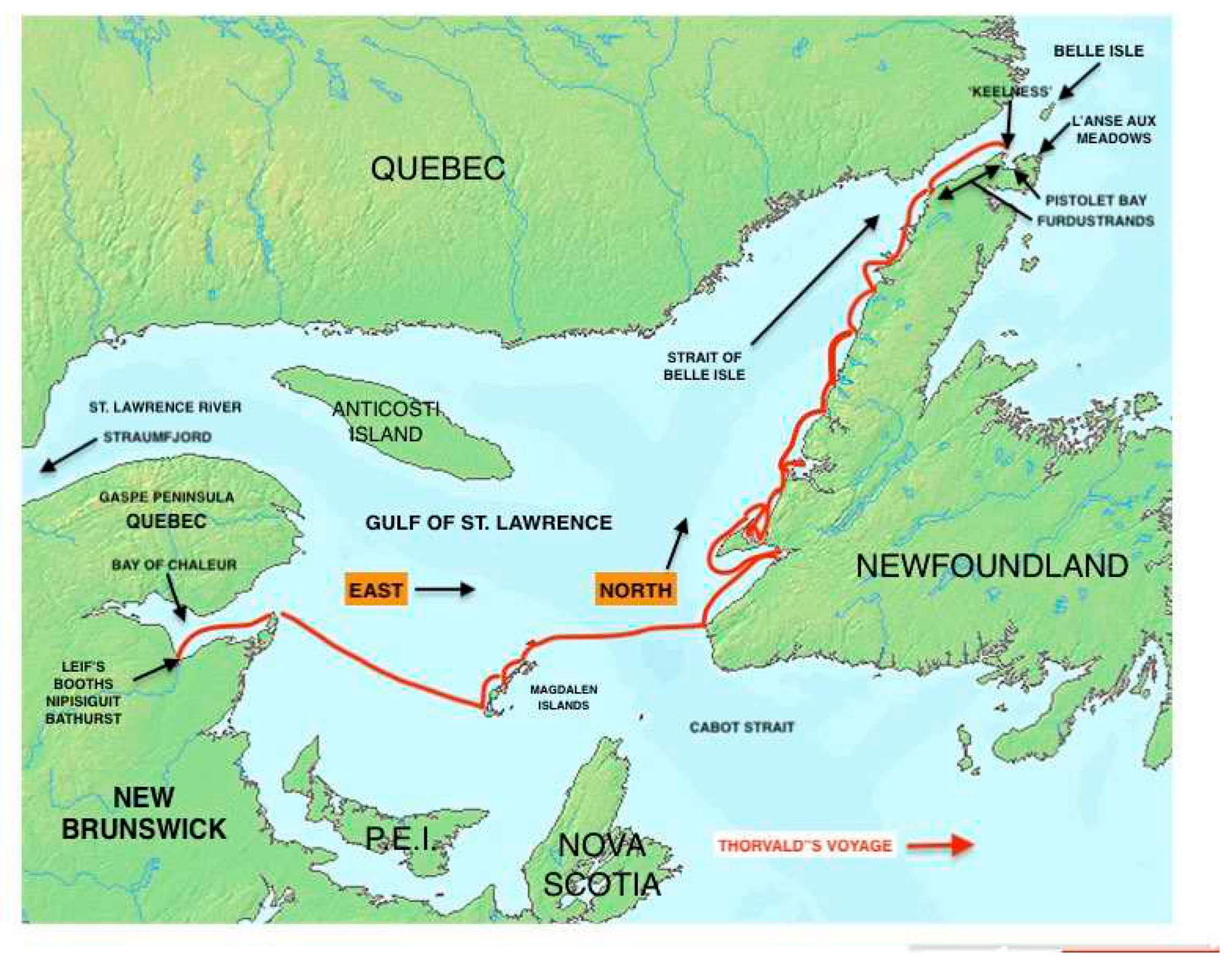
Figure 3.
Underside of reproduction Viking ship, Myklebust, demonstrating extent of damage to Leif's ship during shipwreck; keel and 18 strakes, 9 on each side of keel. (Reproduced by kind permission of photographer Christina Keune).
Figure 3.
Underside of reproduction Viking ship, Myklebust, demonstrating extent of damage to Leif's ship during shipwreck; keel and 18 strakes, 9 on each side of keel. (Reproduced by kind permission of photographer Christina Keune).
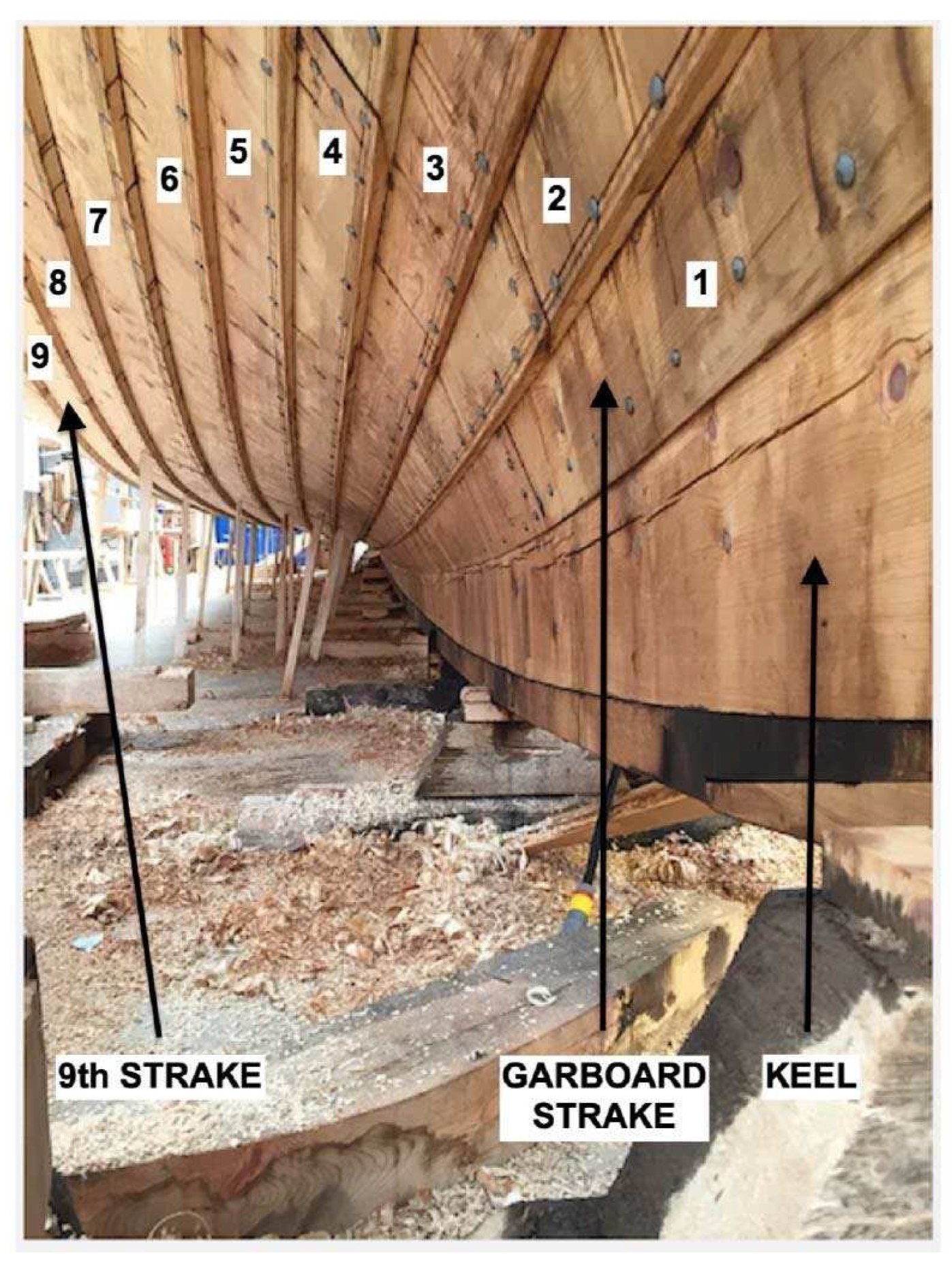
Figure 4.
A,B Comparison images of strake array, visible view (4A) versus hillshade view (4B).
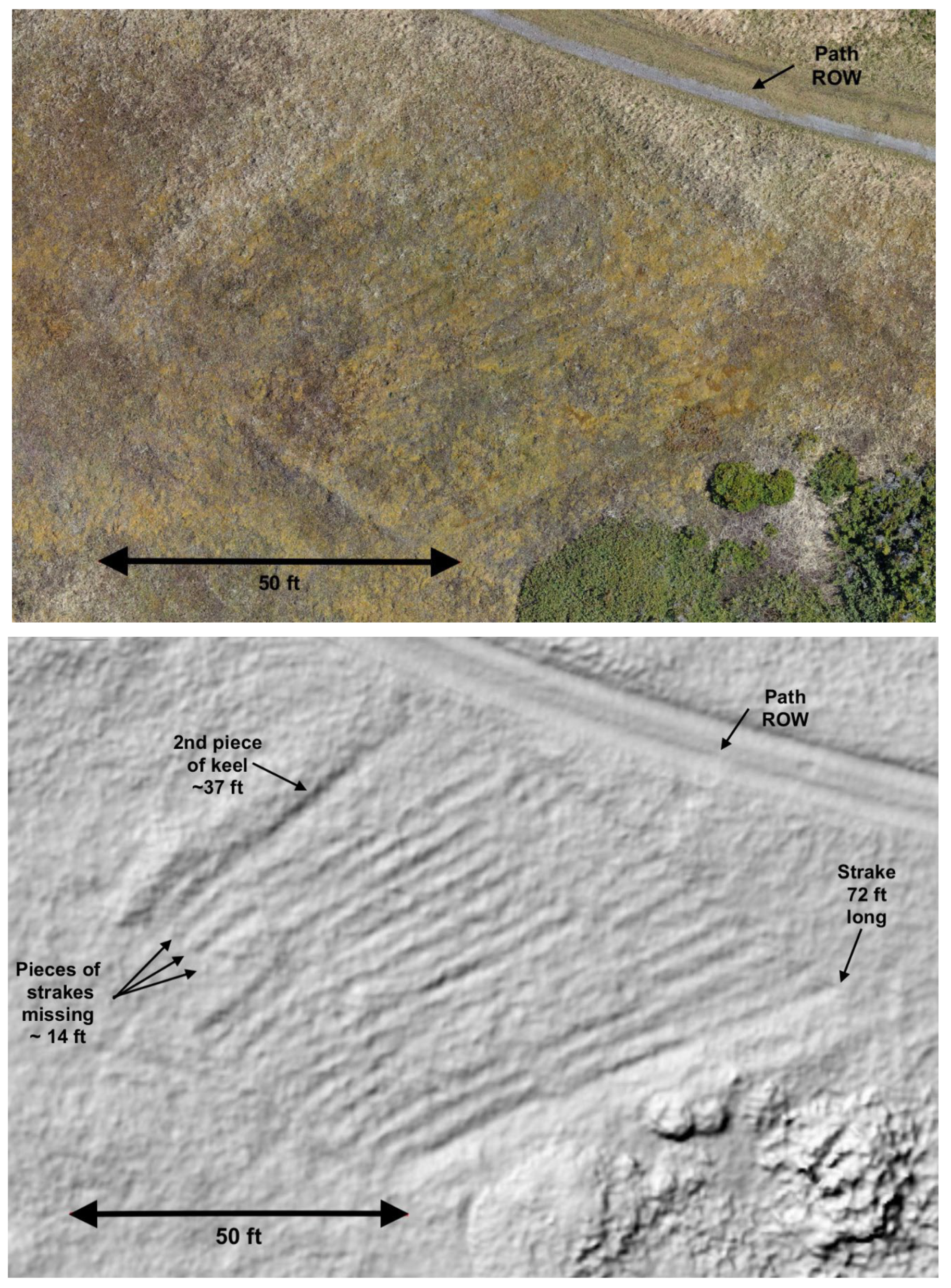
Figure 5.
Overlay of thermal data pattern, over the hillshade rendering of the surface topography.
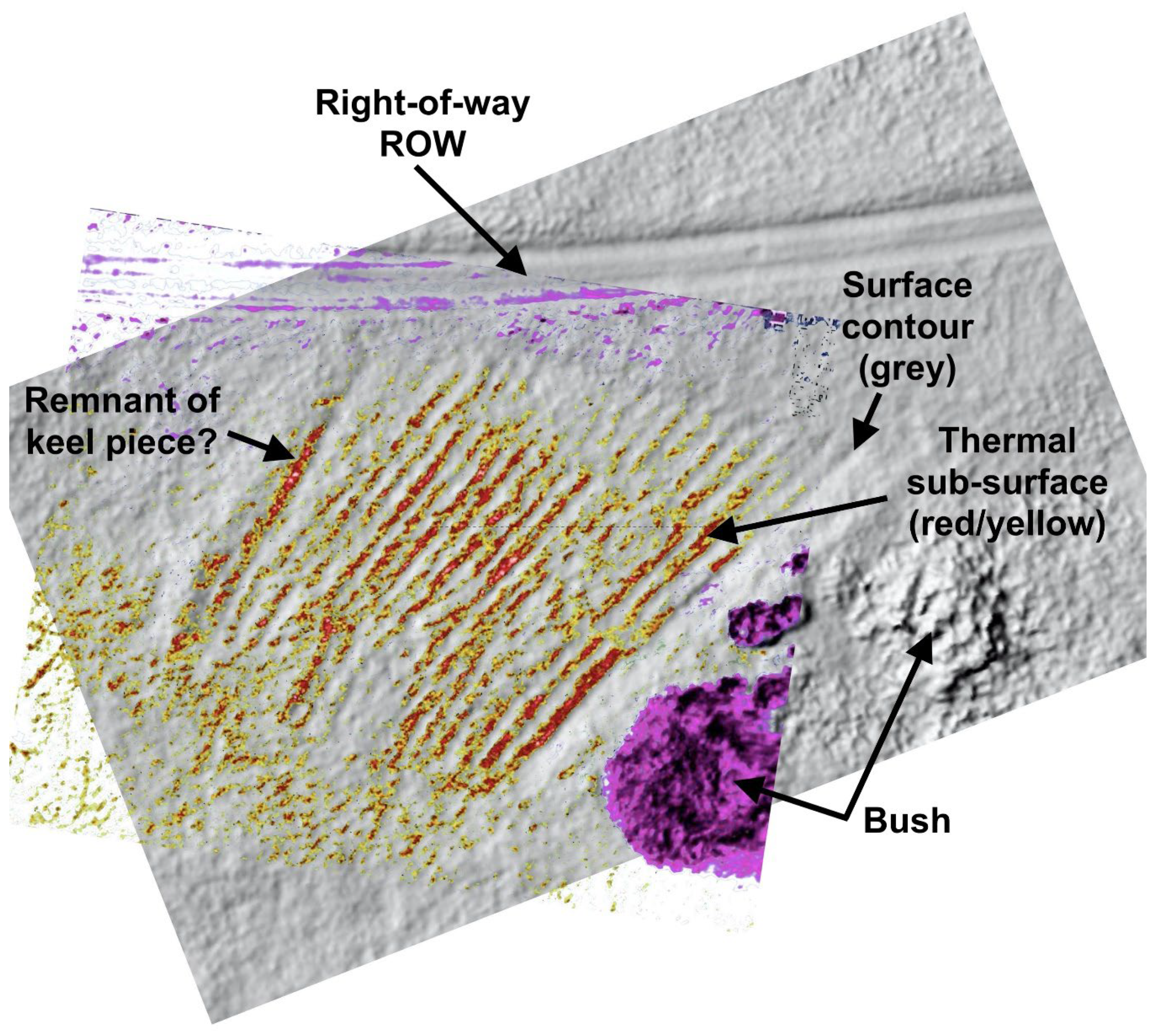
Figure 6.
Enlarged image of part of thermal-over-hillshade overlay rendition of the strake array: showing what appear to be rivet fragments, still embedded in strake wood, and the largely still-intact edge of the outermost strake: 9th out from the keel.
Figure 6.
Enlarged image of part of thermal-over-hillshade overlay rendition of the strake array: showing what appear to be rivet fragments, still embedded in strake wood, and the largely still-intact edge of the outermost strake: 9th out from the keel.
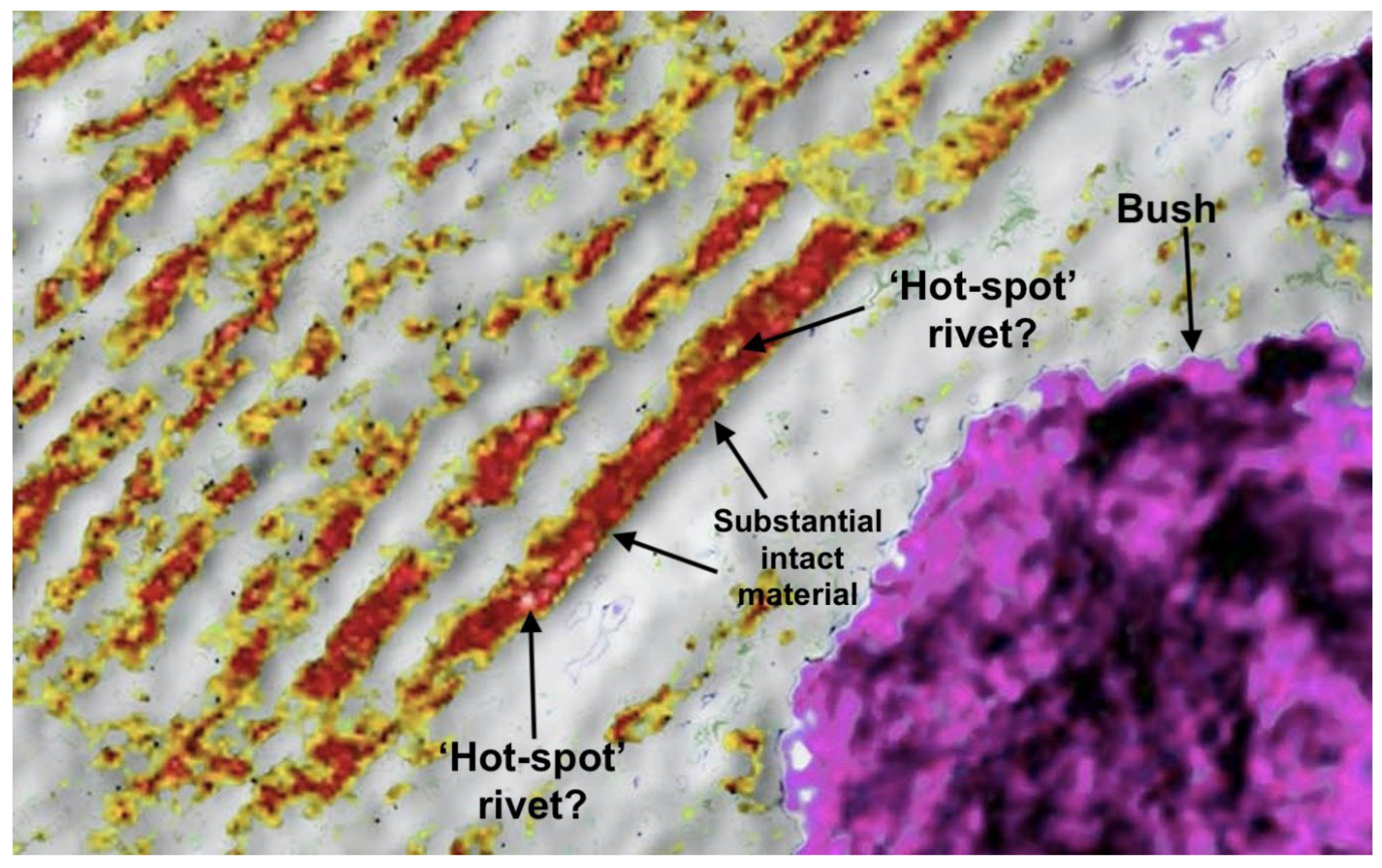
Figure 7.
Hillshade image showing keel-hole & keel impression.
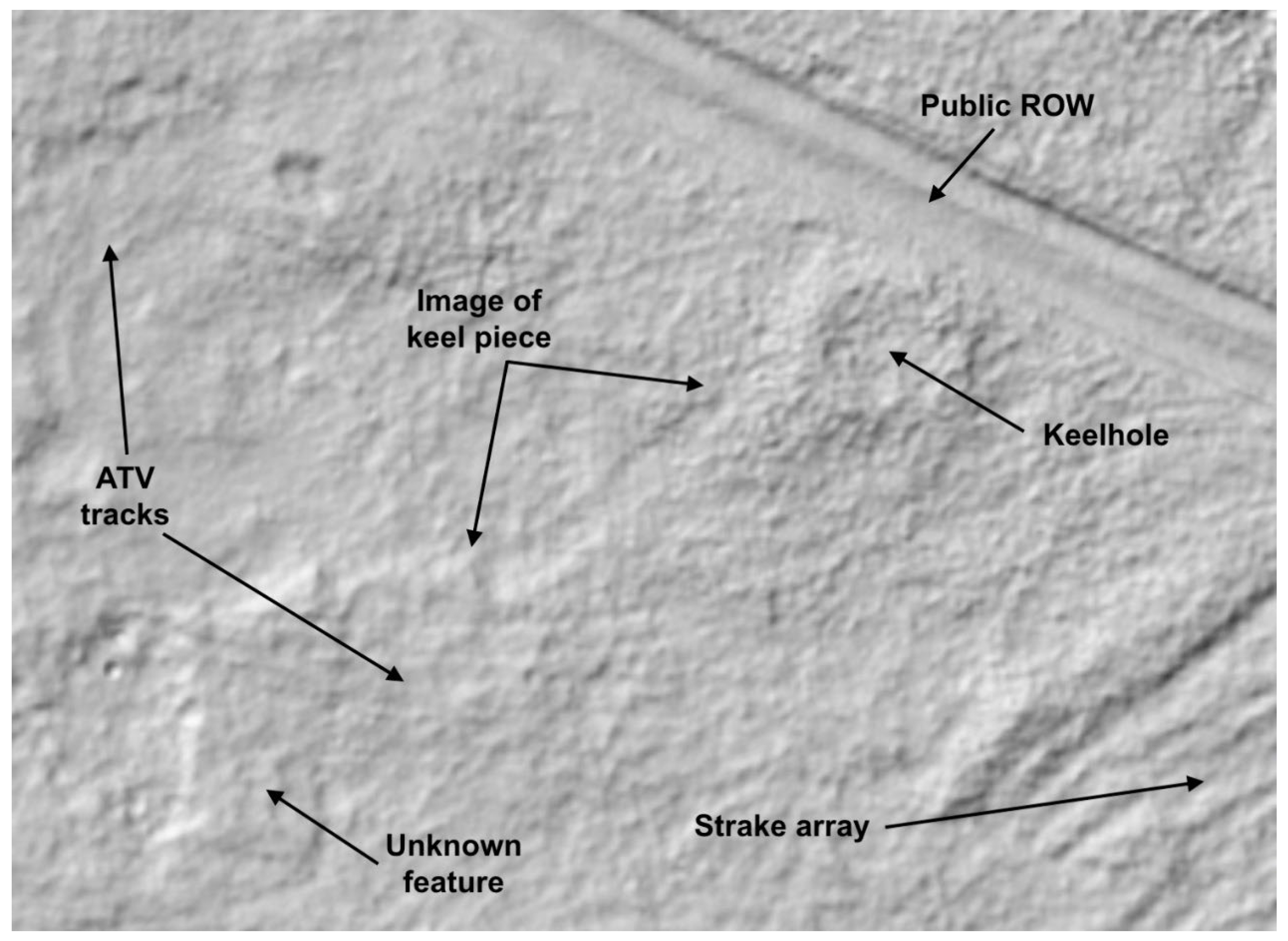
Figure 8.
Modified hillshade image of re-processed drone data, to produce 30 degree view of keel-hole and keel impression features, as viewed from northeast.
Figure 8.
Modified hillshade image of re-processed drone data, to produce 30 degree view of keel-hole and keel impression features, as viewed from northeast.
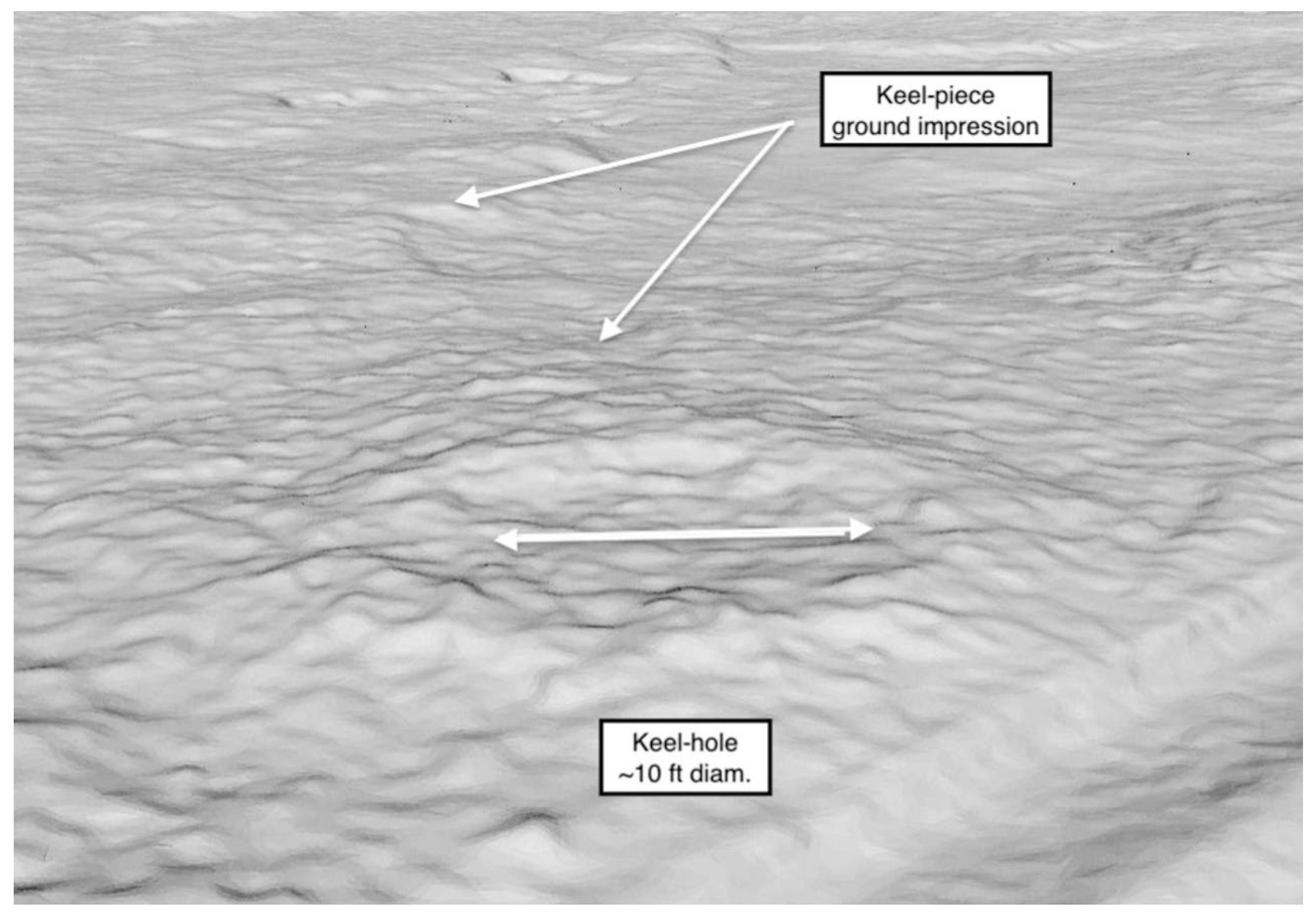
Figure 9.
Modified and annotated image of keel pieces of the Bryggen 'Big Ship', excavated in Bergen, Norway. (14). Shows size, shape, and remarkable similarity to presumed keel-piece image at 'Keelness' (Figure 7A). Hansen, G., The "Big Ship" and the "Second Big Ship": Stratigraphical and Chronological Aspects, The Bryggen Papers, Supplemental Series No.7 - Ships and Commodities, Figure 2, p. 57, University of Bergen (2001).
Figure 9.
Modified and annotated image of keel pieces of the Bryggen 'Big Ship', excavated in Bergen, Norway. (14). Shows size, shape, and remarkable similarity to presumed keel-piece image at 'Keelness' (Figure 7A). Hansen, G., The "Big Ship" and the "Second Big Ship": Stratigraphical and Chronological Aspects, The Bryggen Papers, Supplemental Series No.7 - Ships and Commodities, Figure 2, p. 57, University of Bergen (2001).
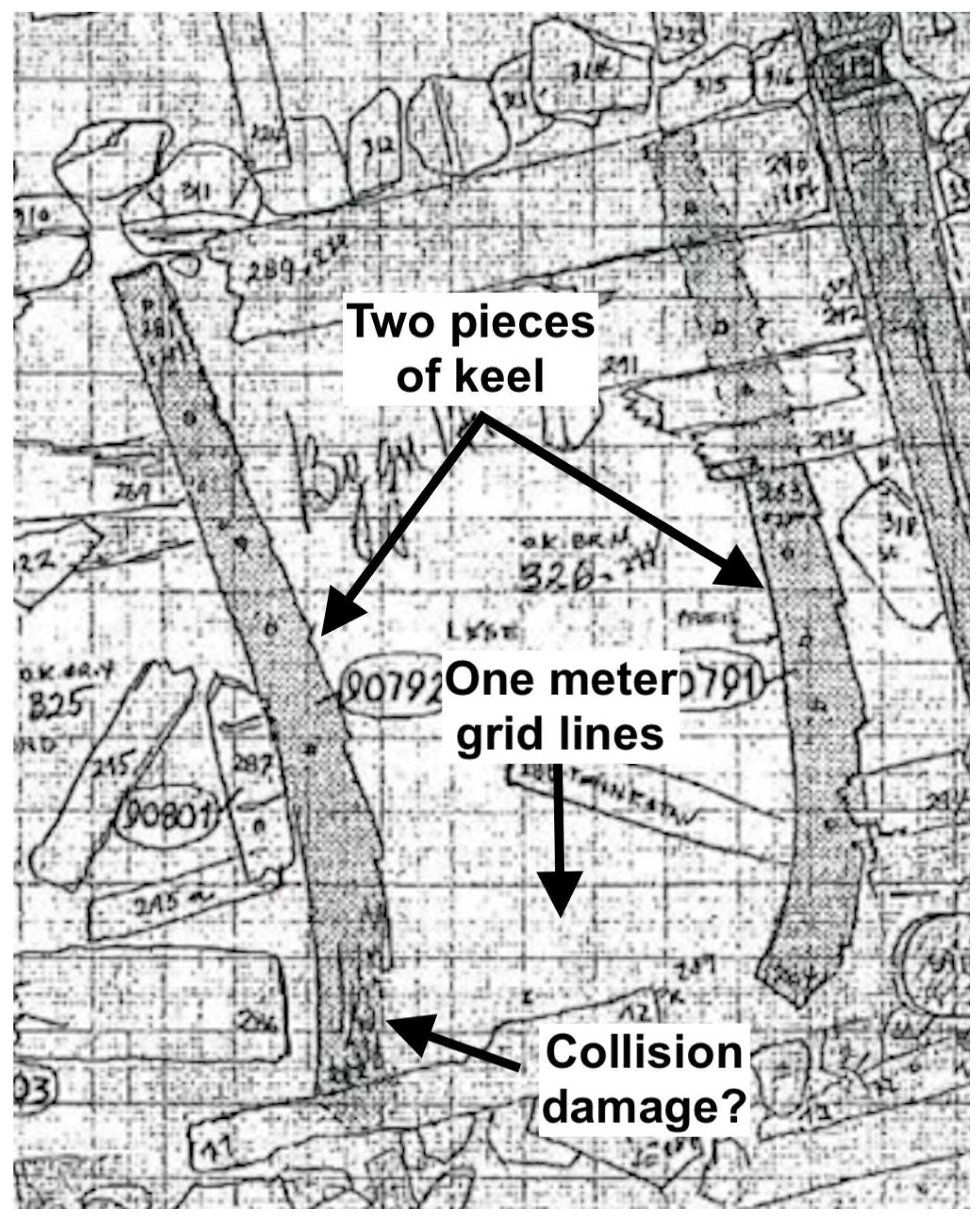
Figure 11.
Annotated map of 'Keelness' area, showing the proximity to authenticated Viking site at L'Anse aux Meadows, suggesting physical and historical connection between the two sites. Also shows likely source for large white spruce trees, needed for shaping into replacement parts for ship, on the south shore of Pistolet Bay.
Figure 11.
Annotated map of 'Keelness' area, showing the proximity to authenticated Viking site at L'Anse aux Meadows, suggesting physical and historical connection between the two sites. Also shows likely source for large white spruce trees, needed for shaping into replacement parts for ship, on the south shore of Pistolet Bay.
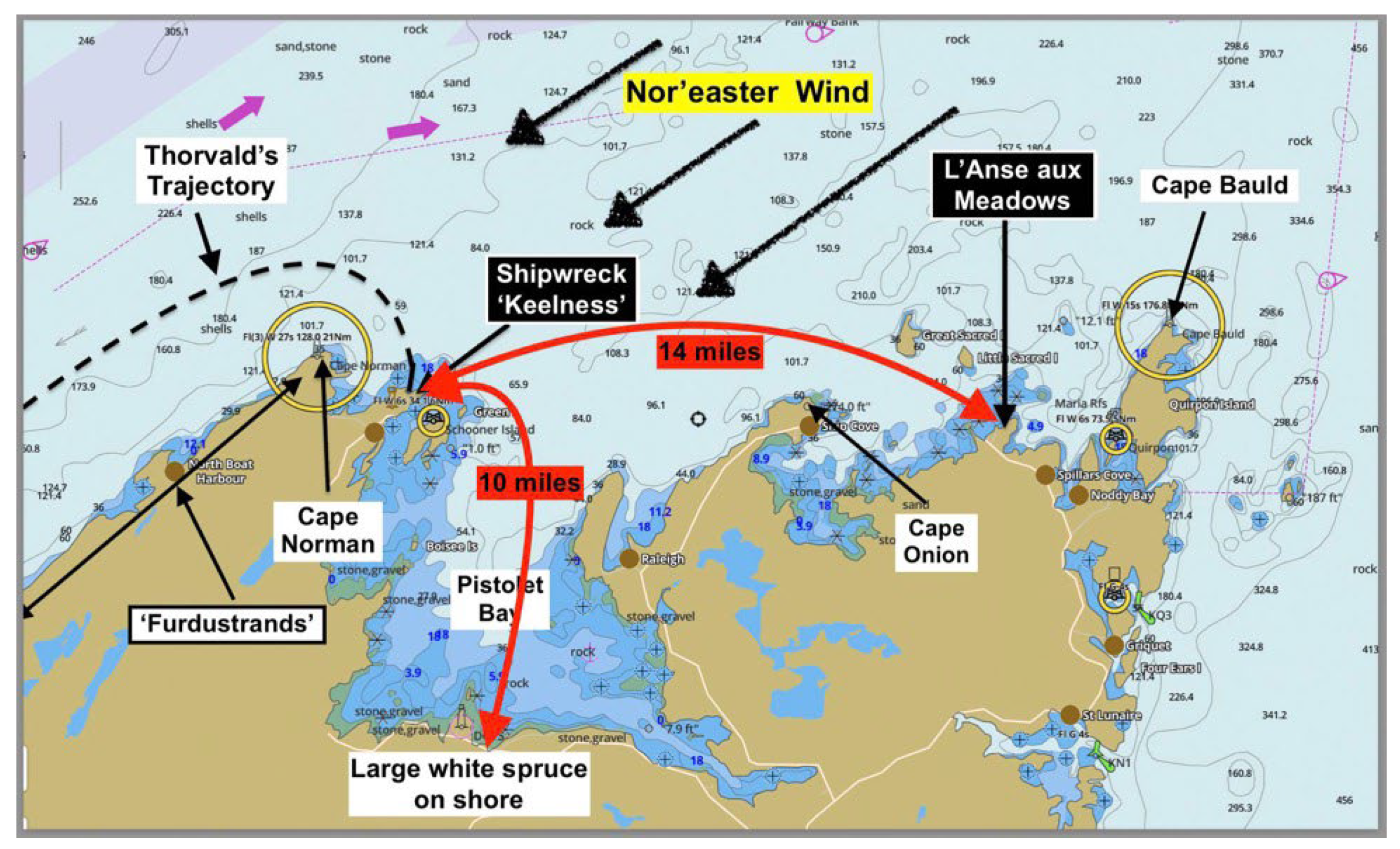
Disclaimer/Publisher’s Note: The statements, opinions and data contained in all publications are solely those of the individual author(s) and contributor(s) and not of MDPI and/or the editor(s). MDPI and/or the editor(s) disclaim responsibility for any injury to people or property resulting from any ideas, methods, instructions or products referred to in the content. |
© 2023 by the authors. Licensee MDPI, Basel, Switzerland. This article is an open access article distributed under the terms and conditions of the Creative Commons Attribution (CC BY) license (http://creativecommons.org/licenses/by/4.0/).
Copyright: This open access article is published under a Creative Commons CC BY 4.0 license, which permit the free download, distribution, and reuse, provided that the author and preprint are cited in any reuse.
Alerts
MDPI Initiatives
Important Links
© 2024 MDPI (Basel, Switzerland) unless otherwise stated




